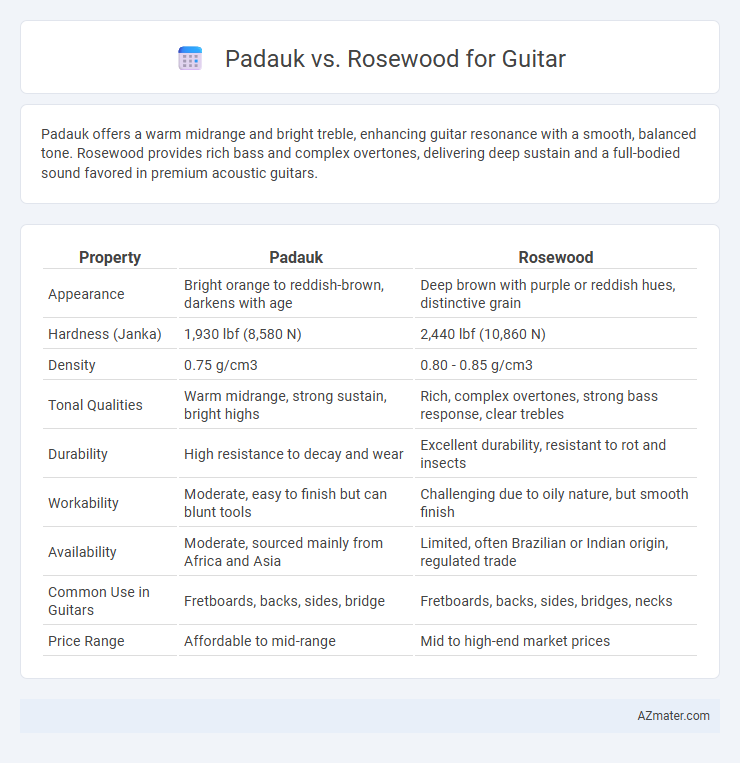Padauk offers a warm midrange and bright treble, enhancing guitar resonance with a smooth, balanced tone. Rosewood provides rich bass and complex overtones, delivering deep sustain and a full-bodied sound favored in premium acoustic guitars.
Table of Comparison
| Property | Padauk | Rosewood |
|---|---|---|
| Appearance | Bright orange to reddish-brown, darkens with age | Deep brown with purple or reddish hues, distinctive grain |
| Hardness (Janka) | 1,930 lbf (8,580 N) | 2,440 lbf (10,860 N) |
| Density | 0.75 g/cm3 | 0.80 - 0.85 g/cm3 |
| Tonal Qualities | Warm midrange, strong sustain, bright highs | Rich, complex overtones, strong bass response, clear trebles |
| Durability | High resistance to decay and wear | Excellent durability, resistant to rot and insects |
| Workability | Moderate, easy to finish but can blunt tools | Challenging due to oily nature, but smooth finish |
| Availability | Moderate, sourced mainly from Africa and Asia | Limited, often Brazilian or Indian origin, regulated trade |
| Common Use in Guitars | Fretboards, backs, sides, bridge | Fretboards, backs, sides, bridges, necks |
| Price Range | Affordable to mid-range | Mid to high-end market prices |
Introduction: Padauk vs Rosewood in Guitar Making
Padauk and rosewood are widely used tonewoods in guitar making, each offering distinct tonal characteristics and visual appeal. Padauk is known for its bright, articulate sound with strong midrange presence, while rosewood provides rich overtones and deep bass response resulting in a warmer, more complex tone. Guitar builders often select rosewood for fingerboards and backs due to its durability and resonance, whereas padauk is favored for its striking reddish hue and clear sound projection.
Botanical Origins and Species Differences
Padauk wood, derived from trees in the Pterocarpus genus native to tropical Africa and Asia, offers a vibrant reddish-orange hue and a dense, durable structure ideal for guitar construction. Rosewood, sourced mainly from Dalbergia species like Dalbergia nigra and Dalbergia latifolia, is prized for its rich, dark color and complex grain patterns, contributing to warm, resonant tones in guitars. While Padauk provides a bright, focused sound and distinctive color, Rosewood's botanical diversity allows for a broader tonal palette and greater aesthetic variety in acoustic and electric guitars.
Appearance: Color, Grain, and Aesthetics
Padauk features a vibrant reddish-orange to deep rusty red color that darkens with age, offering a striking, bold visual appeal. Rosewood displays a rich range of hues from deep brown to purplish or even black streaks, with a dense, oily grain pattern that enhances its luxurious texture. Both woods exhibit unique grain aesthetics; Padauk's coarse, straight grain contrasts with Rosewood's complex, swirling patterns, making each ideal for distinctive guitar finishes.
Tonal Characteristics and Sound Profiles
Padauk wood delivers a bright, crisp tone with strong midrange presence and clear highs, making it ideal for players seeking articulate sound and excellent note definition. Rosewood, known for its rich, complex tonal profile, offers deep bass, warm mids, and sparkling trebles, resulting in a smooth, balanced sound favored in acoustic guitar construction. Both woods enhance projection and sustain, but Padauk emphasizes clarity and punch, while Rosewood provides warmth and harmonic depth.
Workability for Luthiers
Padauk offers excellent workability for luthiers due to its medium density and consistent grain, making it easier to shape and carve compared to harder woods. Rosewood, while prized for its tonal qualities, is denser and more brittle, posing challenges in sanding and intricate detailing. The balance between strength and ease of machining in Padauk often results in faster production times without compromising durability.
Durability and Longevity of Each Wood
Padauk offers exceptional durability with high resistance to wear, decay, and insect damage, making it a sturdy choice for guitar bodies and necks that endure heavy use. Rosewood, known for its dense, oily composition, provides superior longevity by resisting moisture and environmental changes, which helps maintain the instrument's structural integrity and tonal quality over time. Both woods excel in durability, but Rosewood's natural oils and density often contribute to a longer lifespan in guitars exposed to varying climates.
Weight and Playability Considerations
Padauk offers a lighter weight than rosewood, making it ideal for guitarists seeking better portability and reduced arm fatigue during long performances. Rosewood, known for its denser composition, provides enhanced sustain and a richer tonal warmth, which can influence playability by offering a stable feel under the fingers. Weight differences directly affect comfort, while the tactile response of each wood impacts overall handling and string interaction.
Availability, Sustainability, and Cost
Padauk guitars are generally more available and affordable than rosewood, as padauk wood grows faster and is less restricted in trade. Rosewood, especially Brazilian and Indian varieties, faces strict regulations under CITES due to overharvesting, making it less sustainable and significantly more expensive. The sustainability of padauk is higher due to better-managed plantations, offering guitar manufacturers a cost-effective and eco-friendlier alternative.
Common Guitar Types Using Padauk or Rosewood
Common guitar types using Padauk often feature this wood in acoustic guitar backs and sides due to its vibrant reddish hue and balanced tonal warmth, enhancing midrange projection. Rosewood, favored in both electric and acoustic guitars, is prized for its rich overtones, strong sustain, and complex harmonic content, making it a preferred choice for high-end fingerboards and bridges, particularly in dreadnought and classical models. Brands like Martin and Taylor frequently incorporate rosewood for its durability and aesthetic appeal, while Padauk is gaining popularity in boutique guitars for its unique color and responsive sound characteristics.
Conclusion: Choosing the Right Wood for Your Guitar
Padauk offers a bright, punchy tone with excellent midrange clarity, making it ideal for players seeking vibrant sound and visual warmth. Rosewood provides rich, complex overtones and strong bass response, favored by those who desire a traditional, full-bodied acoustic quality. Selecting the right wood depends on your tonal preference and aesthetic taste, with Padauk excelling in modern, cutting soundscapes and Rosewood standing as a classic choice for depth and resonance.

Infographic: Padauk vs Rosewood for Guitar
 azmater.com
azmater.com